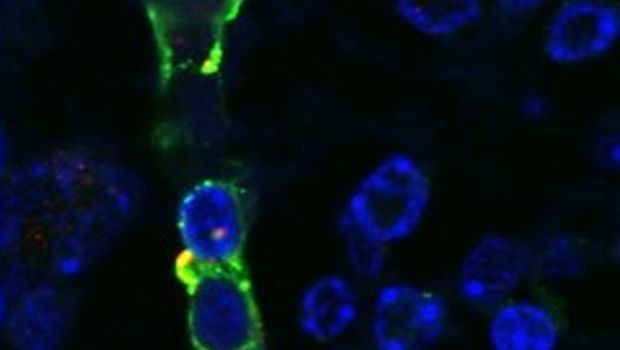Glucose Transporters Blocked in Bacterial Meningitis
Escherichia coli K1 (E. coli K1) continues to be a major threat to the health of young infants. Affecting the central nervous system, it causes neonatal meningitis by multiplying in immune cells, such as macrophages, and then disseminating into the bloodstream to subsequently invade the blood-brain barrier. Neonatal and childhood meningitis in particular results in long-term neurological problems such as seizures or ADHD in up to half of the survivors.


E. coli K1 damages microvessels (green) that constitute the blood-brain barrier in an experimental newborn mouse model of meningitis. Courtesy of Subramanian Krishnan, PhD.
Escherichia coli K1 (E. coli K1) continues to be a major threat to the health of young infants. Affecting the central nervous system, it causes neonatal meningitis by multiplying in immune cells, such as macrophages, and then disseminating into the bloodstream to subsequently invade the blood-brain barrier. Neonatal and childhood meningitis in particular results in long-term neurological problems such as seizures or ADHD in up to half of the survivors.
Meningitis can be caused by bacterial, fungal or viral pathogens. One hallmark of bacterial meningitis is reduced glucose levels in the cerebrospinal fluid (CSF) of patients, which allows a physician to quickly begin appropriate antibiotic treatment.
The reason for the reduced glucose levels associated with bacterial meningitis was believed to be the need for glucose as fuel by infiltrating immune cells in response to infection. However, the possibility that the bacteria itself could manipulate glucose concentrations in the brain had not been explored before now.
Scientists at the Saban Research Institute of Children’s Hospital Los Angeles (CHLA) report that glucose transporters, which transfer glucose from the blood to the brain, are inhibited by E. coli K1 during meningitis.
“We found that expression of glucose transporters is completely shut down by bacteria, leaving insufficient fuel for the immune cells to fight off the infection,” said the study’s first author, Subramanian Krishnan, PhD, of the Division of Infectious Diseases at CHLA.
Specifically, the study – reported online in The Journal of Infectious Diseases – shows that E. coli K1 modulates the protein peroxisome proliferator-activated receptor-gamma (PPAR-γ) and glucose transporter-1 (GLUT-1) levels at the blood-brain barrier in human brain microvascular endothelial cells. This causes inhibition of glucose uptake and the disruption of the blood-brain barrier integrity.
The suppression of PPAR-γ and GLUT-1 levels in mouse models of bacterial meningitis caused extensive neurological effects. The researchers showed that a two-day treatment regimen with partial or selective PPAR-γ agonists (Telmisartan and Rosiglitazone – both FDA-approved drugs) ameliorated the pathological outcomes of infection in mice by inducing expression of glucose transporters.
“Modulation of PPAR-γ and GLUT-1 levels may boost the immune system to fight infection,” said principal investigator Prasadarao V. Nemani, PhD of CHLA and the Keck School of Medicine of the University of Southern California. “Our findings could lead to a novel way of treating children with meningitis and reducing long-term neurological problems.”
Additional contributors to the study include Alexander C. Chang, PhD of CHLA and professor Brian M. Stoltz of the California Institute of Technology. This work was supported by funds from NIAID (AI40567) and NICHD (NS73115).
Source: Childrens Hospital Los Angeles
Show, Tell, Teach: Elevating EVS Training Through Cognitive Science and Performance Coaching
April 25th 2025Training EVS workers for hygiene excellence demands more than manuals—it requires active engagement, motor skills coaching, and teach-back techniques to reduce HAIs and improve patient outcomes.
Phage Therapy’s Future: Tackling Antimicrobial Resistance With Precision Viruses
April 24th 2025Bacteriophage therapy presents a promising alternative to antibiotics, especially as antimicrobial resistance continues to increase. Dr. Ran Nir-Paz discusses its potential, challenges, and future applications in this technology.
Robust infectious disease surveillance, including rapid subtyping of influenza A, is essential for early detection, containment, and public health reporting of novel viral threats.